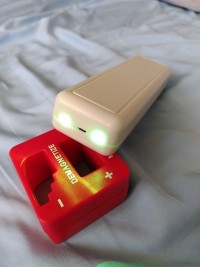Magnet finder

Hey, what is a magnet finder? Simple, what it says it is; it can find magnets. Read the full article.
Where do you want that for?
Ah, I explain. I am a volunteer at a Repair Cafe. And lately we are offered more and more with complicated coffee making machines for the home-barrista.
And because these machines are expensive the designers have the option to build in safety measures, like the check if all the removable parts (which the home-barrista should clean regulary) are present before the grinding, boiling and coffeemaking takes place.
Recently I came upon such a machine which would not function at all because certain trays were not installed. At least that is what the microcontroller inside the machine indicated with a red icon.
But everything was installed. So the search for the switch which indicates the tray present was started. And failed. Because a mechanical switch is not the ideal component in an area of coffeebeans, grinded coffeepowder, water, steam and electricity. So the designers opted for a proximity switch. Somewhere in the removeable parts are small magnets installed. And on the opposite side, safely in the enclosure of the machine is a Hall sensor informing the microcontroller that the part is correctly inserted.
So, if you had a magnet, you could simulate the presence of the part?
Yes, I could. Except I had no magnet with me. And I like electronics, so I like to find a electronical solution.
Will a simple Hall-sensor do the job?
You are right. Instead of the Hall-sensor in the coffeemachine, the finder exists of a small handheld enclosure with a Hall-sensor, running on two AAA cells. When it detects a magnet, it triggers a BC557B transistor, which lights up two bright green Leds. That's it.
Really, that is all?
Quite almost. There is also a manual switch to switch the whole thing on and off. And a capacitor which let the leds flash when you switch it on. Handy to know that the finder functions. Otherwise you might end up searching with a defective finder.
I want to know more. Maybe I like to build one myself.
Go ahead. It is a very simple device. I put some pictures of mine, together with a schematic and a layout of a strips print in the “Project Elements”.
Ah, I explain. I am a volunteer at a Repair Cafe. And lately we are offered more and more with complicated coffee making machines for the home-barrista.
And because these machines are expensive the designers have the option to build in safety measures, like the check if all the removable parts (which the home-barrista should clean regulary) are present before the grinding, boiling and coffeemaking takes place.
Recently I came upon such a machine which would not function at all because certain trays were not installed. At least that is what the microcontroller inside the machine indicated with a red icon.
But everything was installed. So the search for the switch which indicates the tray present was started. And failed. Because a mechanical switch is not the ideal component in an area of coffeebeans, grinded coffeepowder, water, steam and electricity. So the designers opted for a proximity switch. Somewhere in the removeable parts are small magnets installed. And on the opposite side, safely in the enclosure of the machine is a Hall sensor informing the microcontroller that the part is correctly inserted.
So, if you had a magnet, you could simulate the presence of the part?
Yes, I could. Except I had no magnet with me. And I like electronics, so I like to find a electronical solution.
Will a simple Hall-sensor do the job?
You are right. Instead of the Hall-sensor in the coffeemachine, the finder exists of a small handheld enclosure with a Hall-sensor, running on two AAA cells. When it detects a magnet, it triggers a BC557B transistor, which lights up two bright green Leds. That's it.
Really, that is all?
Quite almost. There is also a manual switch to switch the whole thing on and off. And a capacitor which let the leds flash when you switch it on. Handy to know that the finder functions. Otherwise you might end up searching with a defective finder.
I want to know more. Maybe I like to build one myself.
Go ahead. It is a very simple device. I put some pictures of mine, together with a schematic and a layout of a strips print in the “Project Elements”.



Discussion (4 comments)